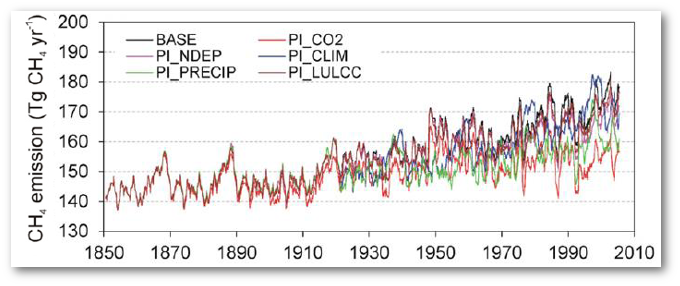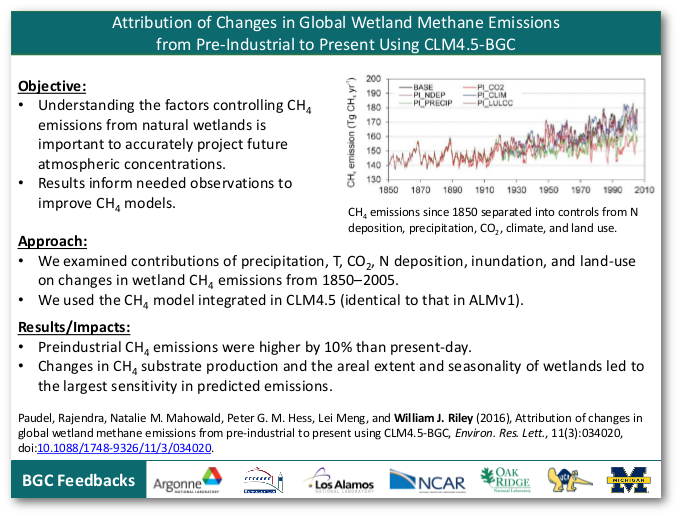Research Highlights
Attribution of changes in global wetland methane emissions from pre-industrial to present using CLM4.5-BGC
March 10, 2016
We examined the relative contributions of climatic and environmental factors, such as precipitation, temperature, atmospheric CO2 concentration, nitrogen deposition, wetland inundation extent, and land-use and land-cover change, on changes in wetland methane emissions from preindustrial to present day (i.e., 1850–2005). We applied a mechanistic methane biogeochemical model integrated in the Community Land Model version 4.5 (CLM4.5), the land component of the Community Earth System Model. The methane model explicitly simulates methane production, oxidation, ebullition, transport through aerenchyma of plants, and aqueous and gaseous diffusion. We conducted a suite of model simulations, with all changes in environmental factors included, and sensitivity studies isolating each factor. Globally, we estimate that preindustrial methane emissions were higher by 10% than present-day emissions from natural wetlands, with emissions changes from preindustrial to the present of +15%, −41%, and −11% for the high latitudes, temperate regions, and tropics, respectively. The most important change is due to the estimated change in wetland extent, due to the conversion of wetland areas to drylands by humans. This effect alone leads to higher preindustrial global methane fluxes by 33% relative to the present, with the largest change in temperate regions (+80%). These increases were partially offset by lower preindustrial emissions due to lower CO2 levels (10%), shifts in precipitation (7%), lower nitrogen deposition (3%), and changes in land-use and landcover (2%). Cooler temperatures in the preindustrial regions resulted in our simulations in an increase in global methane emissions of 6% relative to present day. Much of the sensitivity to these perturbations is mediated in the model by changes in methane substrate production and the areal extent of wetlands.
Objective
- Understanding the factors controlling CH4 emissions from natural wetlands is important to accurately project future atmospheric concentrations.
- Results inform needed observations to improve CH4 models.
Approach
- We examined contributions of precipitation, T, CO2, N deposition, inundation, and land-use on changes in wetland CH4 emissions from 1850–2005.
- We used the CH4 model integrated in CLM4.5 (identical to that in ALMv1).
 |
CH4 emissions since 1850 separated into controls from N deposition, precipitation, CO2, climate, and land use. |
Results/Impacts
- Preindustrial CH4 emissions were higher by 10% than present-day.
- Changes in CH4 substrate production and the areal extent and seasonality of wetlands led to the largest sensitivity in predicted emissions.
Paudel, Rajendra, Natalie M. Mahowald, Peter G. M. Hess, Lei Meng, and William J. Riley. March 10, 2016. “Attribution of Changes in Global Wetland Methane Emissions from Pre-industrial to Present Using CLM4.5-BGC.” Environ. Res. Lett., 11(3):034020. doi:10.1088/1748-9326/11/3/034020.
